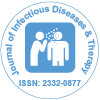Nuestro grupo organiza más de 3000 Series de conferencias Eventos cada año en EE. UU., Europa y América. Asia con el apoyo de 1.000 sociedades científicas más y publica más de 700 Acceso abierto Revistas que contienen más de 50.000 personalidades eminentes, científicos de renombre como miembros del consejo editorial.
Revistas de acceso abierto que ganan más lectores y citas
700 revistas y 15 000 000 de lectores Cada revista obtiene más de 25 000 lectores
Indexado en
- Índice Copérnico
- Google Académico
- Abrir puerta J
- Búsqueda de referencia
- Universidad Hamdard
- EBSCO AZ
- OCLC-WorldCat
- publones
- Pub Europeo
- ICMJE
Enlaces útiles
Revistas de acceso abierto
Comparte esta página
Abstracto
Prevalence of Immunity against Infection of Hepatitis A and Hepatitis B in Children Cochabamba, Bolivia
Dávalos-Gamboa MR, Masuet-Aumatell C, Ramon-Torrell JM, Rituerto AC, Navarro MB and Rodríguez SLM
Background: Knowing the immune status against Hepatitis A and Hepatitis B in children Cochabamba, Bolivia and seroepidemiological association.
Study method: A seroepidemiological study (n=424) and HBV (n=436) of HAV in children living in Cochabamba, Bolivia, 2010. A questionnaire was completed by parents for demographics, socioeconomic was performed and housing and blood samples were collected, An ELISA was used to measure antibodies to hepatitis A and B.
Results: As regards Hepatitis A, the overall prevalence 95.4 (95% CI -93.5 to 97.4) were immune. The immunity was higher in children of 5-10 years (97%) and tweens 10-13 years (97.9%), the prevalence of immunity was also higher in subjects whose parents had a low level of education (99, 4 to 99.5%) living in rural areas (98.7%) lived in municipalities with an urban development under (99.1 to 100%), had water delivered home by an oil sisterna (99.4%) and spoke Quechua at home (99.5%). As to Hepatitis B virus, immunity that presented to the IgG anti-HBs IgG antibodies in the cohort of pre-universal vaccine was 5.8% (95% CI: 3.3 to 8.3%); was higher in men (9.1%), and those living in the suburbs (9.7%). The anti-
HBsIgG prevalence among cohort universal post-vaccine was 37.9% (95% CI: 28.5 to 48.1%), and was higher in children who speak Quechua at home (51.0% ), those living in the suburbs (53.9%), and those born in 2005 (72.7%). Neither cohort showed differences concerning education of parents. The prevalence of IgG anti-HBc was 1.1% among post universal vaccine cohort and 1.2% among pre-universal vaccine cohorts (p>0.05).
Conclusion: The susceptibility to infection by the hepatitis A child reaches 4.5%. There is a high susceptibility of contracting hepatitis B infection by low immunity was identified.
Revistas por tema
- Agricultura y acuicultura
- Alimentación y Nutrición
- Bioinformática y biología de sistemas
- Bioquímica
- Ciencia de los Materiales
- Ciencia general
- Ciencias Ambientales
- Ciencias Clínicas
- Ciencias farmacéuticas
- Ciencias Médicas
- Ciencias Sociales y Políticas
- Ciencias Veterinarias
- Enfermería y atención sanitaria
- Física
- Genética y biología molecular
- Geología y Ciencias de la Tierra
- Ingeniería
- Inmunología y Microbiología
- Química
Revistas clínicas y médicas
- Anestesiología
- Biología Molecular
- Cardiología
- Cirugía
- Cuidado de la salud
- Dermatología
- Diabetes y Endocrinología
- Enfermedades infecciosas
- Enfermería
- Gastroenterología
- Genética
- Inmunología
- Investigación clínica
- Medicamento
- Microbiología
- Neurología
- Odontología
- Oftalmología
- Oncología
- Pediatría
- Toxicología

 English
English  Chinese
Chinese  Russian
Russian  German
German  French
French  Japanese
Japanese  Portuguese
Portuguese  Hindi
Hindi